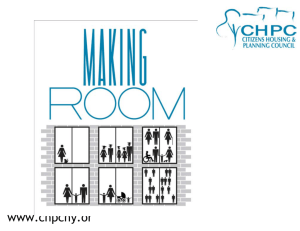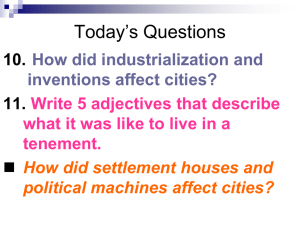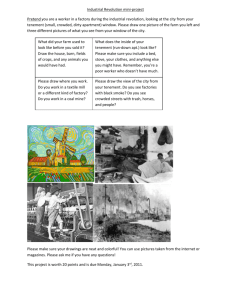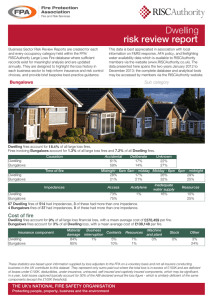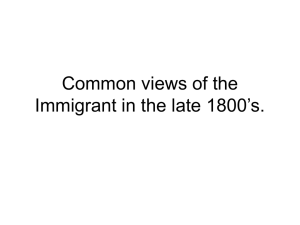risk review report Dwelling
advertisement
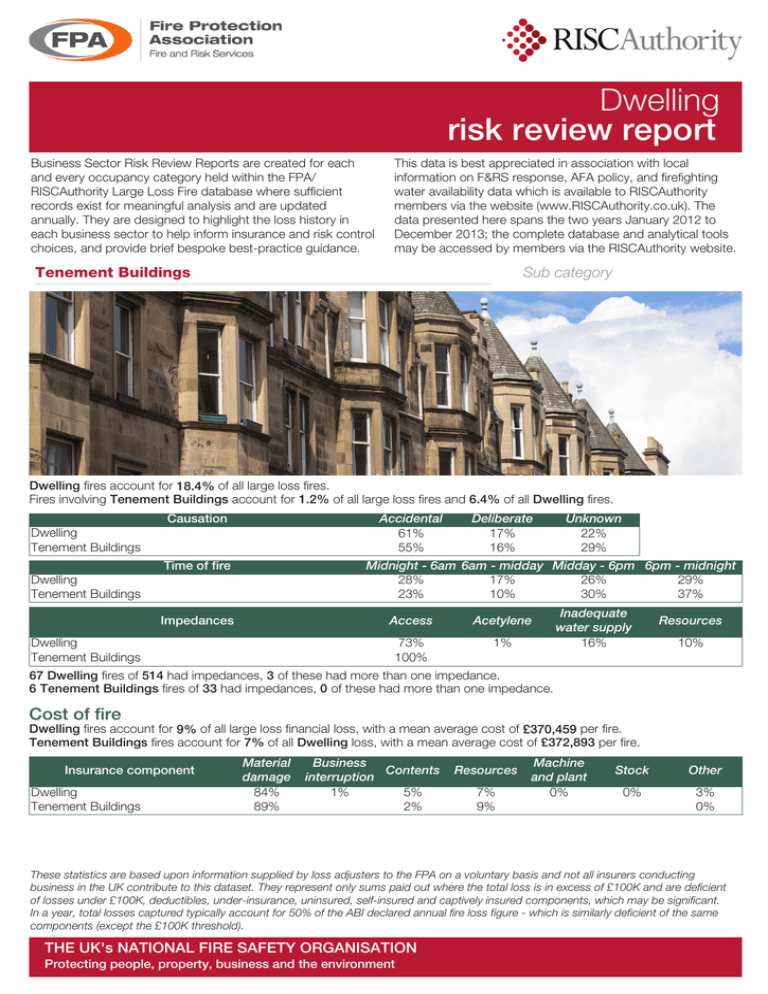
Dwelling risk review report Business Sector Risk Review Reports are created for each and every occupancy category held within the FPA/ RISCAuthority Large Loss Fire database where sufficient records exist for meaningful analysis and are updated annually. They are designed to highlight the loss history in each business sector to help inform insurance and risk control choices, and provide brief bespoke best-practice guidance. This data is best appreciated in association with local information on F&RS response, AFA policy, and firefighting water availability data which is available to RISCAuthority members via the website (www.RISCAuthority.co.uk). The data presented here spans the two years January 2012 to December 2013; the complete database and analytical tools may be accessed by members via the RISCAuthority website. Tenement Buildings Sub category Dwelling fires account for 18.4% of all large loss fires. Fires involving Tenement Buildings account for 1.2% of all large loss fires and 6.4% of all Dwelling fires. Accidental 61% 55% Causation Dwelling Tenement Buildings Dwelling Tenement Buildings Time of fire Deliberate 17% 16% Unknown 22% 29% Midnight - 6am 6am - midday Midday - 6pm 6pm - midnight 17% 26% 29% 28% 23% 10% 30% 37% Impedances Dwelling Tenement Buildings Access Acetylene 73% 100% 1% Inadequate water supply 16% Resources 10% 67 Dwelling fires of 514 had impedances, 3 of these had more than one impedance. 6 Tenement Buildings fires of 33 had impedances, 0 of these had more than one impedance. Cost of fire Dwelling fires account for 9% of all large loss financial loss, with a mean average cost of £370,459 per fire. Tenement Buildings fires account for 7% of all Dwelling loss, with a mean average cost of £372,893 per fire. Insurance component Dwelling Tenement Buildings Material damage 84% 89% Business Contents interruption 1% 5% 2% Resources 7% 9% Machine and plant 0% Stock Other 0% 3% 0% These statistics are based upon information supplied by loss adjusters to the FPA on a voluntary basis and not all insurers conducting business in the UK contribute to this dataset. They represent only sums paid out where the total loss is in excess of £100K and are deficient of losses under £100K, deductibles, under-insurance, uninsured, self-insured and captively insured components, which may be significant. In a year, total losses captured typically account for 50% of the ABI declared annual fire loss figure - which is similarly deficient of the same components (except the £100K threshold). THE UK's NATIONAL FIRE SAFETY ORGANISATION Protecting people, property, business and the environment FPA BUSINESS SECTOR RISK REVIEW REPORT FOR DWELLING – TENEMENT BUILDINGS Fire safety legislation Although private dwellings are not subject to fire safety legislation, a fire risk assessment should be undertaken for the common areas of premises comprising flats, maisonettes and similar properties in compliance with the Regulatory Reform (Fire Safety) Order 2005 (or equivalent legislation in Scotland and Northern Ireland. Fire hazards There are a number of significant fire hazards associated with the common areas of tenement buildings; these include: • Electrical fire hazards from poorly sited consumer units and poorly maintained installations. • Space heaters. • Deliberate fire raising. • Breaches of the fire compartmentation of the building by contractors and others. • Residents changing their front doors for non-fire rated products. • Residents interfering with smoke detectors and other fire safety provisions. • Furniture, artificial flowers, artwork, children’s toys and other combustible materials introduced onto the escape routes. • The accumulation of mail and flyers inside the building. • Rubbish bins and accumulated waste materials in close proximity to the building. • Unprotected letter slots in front doors. • Poorly parked vehicles outside obstructing hydrants and access for firefighting vehicles. Risk control recommendations The following risk mitigation measures should be considered to eliminate or reduce the risk of fire in the common areas of tenement buildings: • Give careful consideration to the likelihood of deliberate fire raising at the time of the fire risk assessment. Suitable security measures should be implemented that are proportionate to the risk and based on the findings of the risk assessment. These measures may include providing locks complying with BS 3621 and installing security lighting. • Review the fire risk assessment periodically, when refurbishment is planned or whenever there are significant changes to the potential sources of ignition, combustible materials present or the abilities of the residents (for example restricted mobility or impaired hearing). • Ensure that escape routes are kept free from obstructions and combustible materials. Furniture, artificial flowers, artwork, children’s toys and other personal effects should not be stored on the escape routes, which should, as far as practicable, be free from combustible materials and potential sources of ignition. • Display prominent notices indicating that the lift(s) should not be used in the event of fire where appropriate. • Unless there is sufficient borrowed light, emergency lighting should be provided; it should be designed, • • • • • • • • • • • installed, commissioned and maintained in accordance with BS 5266 by an electrician with third party certification. Ensure that fire doors are maintained and identified by suitable signs; they should normally be kept shut to minimise the spread of fire. Where fire doors are designed to close automatically on actuation of the fire detection and alarm system, this function should be tested weekly. Ensure that front doors to flats are not changed without the permission of the owner or managing agent as they normally form a vital element of the fire compartmentation of the building. Keep all plant rooms and service ducts locked shut. When designing new premises avoid the need to introduce letter slots in fire doors. Rather than having a letter slot for each flat it is preferable to provide letter boxes in the lobby or outside the building. The latter also provides for greater security for the premises and prevents uncollected or unwanted mail and flyers from accumulating inside. Where letter slots are provided in the front doors to flats, they should be protected (for example by intumescent materials), to provide the same degree of fire resistance as the door in which they are located. Maintain the installed heating in accordance with the manufacturer’s instructions. Prohibit the use of unauthorised portable heaters in common areas. Eliminate hot work wherever possible, including the use of hot air guns for the stripping of paintwork during redecoration. When hot work cannot be avoided, minimise the time that gas cylinders are in the premises. Ensure that the work is controlled by use of a hot work permit system in accordance with RISCAuthority Recommendation RC7. Ensure that electrical installations are designed, installed and periodically tested by a competent electrician in accordance with the current edition of BS 7671 (the IET Wiring Regulations). Inspections should be carried out on a risk assessed basis as recommended in the Periodic Inspection Report. Arrange for any portable electrical equipment (such as vacuum cleaners) that are to be used in the common areas by cleaners and other staff to be inspected and tested at least in accordance with HSG 107 and/or the IET Code of practice for in-service inspection and testing of electrical equipment. The period between tests should be determined by risk assessment. Ensure that electrical and gas installations (such as meters and electrical consumer units) are separated from common areas by a form of construction that provides at least 30 minutes’ fire resistance. Minimise the spread of fire by effective fire compartmentation within the building. Maintain the compartmentation by ensuring that contractors provide suitable fire stopping, in accordance with the FPA Design guide, around pipes and services that pass through fire compartment walls, floors and ceilings. Maintain the effectiveness of cavity barriers in ceilings and roof voids. • Provide written information for the residents indicating the steps that they should take in the event of fire. It should be made clear whether there is a full evacuation or ‘stay put’ policy and how the residents should call the fire and rescue service. Residents should also be made aware of heat or smoke detectors in their flats and how they should be tested and maintained. • Where there is a full evacuation policy, residents need to be warned of a fire in the premises thus a suitable automatic fire detection and alarm system should be installed. The system should have third party certification by a UKAS accredited certification body and be to a recognised category of installation in accordance with BS 5839-6. • Give serious consideration at the design stage to the installation of an automatic fire suppression system, such as water sprinklers, which should be installed in compliance with the Sprinkler Rules incorporating BS EN 12845. • Provide a suitable number of appropriate fire extinguishers in any common area such as a laundrette or room for charging mobility scooters; portable fire extinguishers are not required in escape routes. Extinguishers should be approved and certificated by an independent, third party certification body, installed in accordance with BS 5306-8 and inspected and maintained in compliance with BS 5306-3. • Minimise the storage of combustible waste materials (including unwanted furniture and recycling containers) within 10m of the premises. Where appropriate, provide bollards or kerbs to prevent wheeled bins being located against external cladding or beneath windows. • Liaise with the fire and rescue service where car parking in the neighbourhood may prevent speedy access by firefighting appliances. • Have an effective emergency plan in place to ensure the resilience of the premises and welfare of the residents in the event of a fire. One way of approaching this is to complete the ROBUST business continuity and incident management planning software available free from https://robust.riscauthority.co.uk/ Further information 1. Regulatory Reform (Fire Safety) Order 2005, SI 2005 No 1541, TSO. 2. The Fire (Scotland) Act 2005, asp 5, TSO. 3. Fire Safety (Scotland) Regulations 2006, Scottish SI 2006 No 456, TSO. 4.Fire and Rescue Services (Northern Ireland) Order 2006, SI 2006 No 1254 (NI9), TSO. 5.Fire Safety Regulations (Northern Ireland) 2010, SI 2010 No 325 (NI), TSO. 6. BS 3621: 2007 + A2: 2012, Thief resistant lock assembly. Key egress, BSI. 7. BS 5266-1:2011: Emergency lighting. Code of practice for the emergency escape lighting of premises, BSI. Case history 1. Councillors have ordered the owners of a fire-damaged tenement to replace its lost roof. They agreed to have a work notice served on the premises despite a claim from a developer that the move was unnecessary and ‘vigorously opposed’ by the owners. The tenement remained empty two years after the blaze. The project manager told the housing committee he represented nine of the 10 owners. He disagreed with the council’s contention that a new roof was needed to prevent further damage to the building and to the adjacent property and took issue with the suggested £180,000 cost. He said: ‘The majority of the owners of 14 Garland Place are fully committed to having the building restored and have repeatedly requested meetings with the council to have pre-building warrant application talks but the council have refused to agree to a meeting.’ 8. BS 5306-3: 2009: Fire extinguishing installations and equipment on premises. Commissioning and maintenance of portable fire extinguishers. Code of practice, BSI. 9. BS 5306-8: 2012: Fire extinguishing installations and equipment on premises. Selection and positioning of portable fire extinguishers. Code of practice, BSI. 10.BS 5839-6: 2013: Fire detection and fire alarm systems for buildings. Code of practice for the design, installation, commissioning and maintenance of fire detection and fire alarm systems in domestic premises, BSI. 11.BS 7671: 2008 +A1: 2011 + A2: 2013: Requirements for electrical installations (IET Wiring Regulations), BSI. 12.LPC Rules for automatic sprinkler installations incorporating BS EN 12845: (Fixed firefighting systems. Automatic sprinkler systems. Design, installation and maintenance, BSI), 2009, FPA. 13.RC7: Recommendations for hot work, 2012, FPA. 14.Business resilience: A guide to protecting your business and its people, 2005, FPA. 15.ROBUST software (Resilient Business Software Toolkit): https://robust.riscauthority.co.uk 16.FPA Design guide: The protection of buildings: Core document: Protection of openings and service penetrations from fire, 2005, FPA. 17.HSG 107: Maintaining portable and transportable electrical equipment, 2013, HSE. 18.Code of practice for in-service inspection and testing of electrical equipment, 2012, Institution of Engineering and Technology (IET). 19.Fire safety risk assessment: Sleeping accommodation, 2006, DCLG. 20.Fire safety in purpose-built blocks of flats, 2011, Local Government Group.
